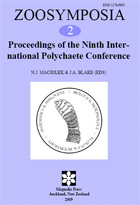Abstract
Though most common in coastal sandy bottoms, nerillid annelids have been found in a broad variety of habitats around the world and two genera have previously been reported from the deep sea. During a cruise to the southern East Pacific Rise and northern Pacific Antarctic Ridge (near Easter Island) in 2005, six specimens of a new species of Mesonerilla were collected at depths of 2234–2649 m. Samples were taken via DSV Alvin with a slurp gun collecting fine silt and volcanic glass shards in cracks, fissures, and mussel beds from 5–20 m away from active venting areas. As well as being the first deep-sea hydrothermal vent associated nerillid, this is the first record of an adult meiofaunal annelid from deep-sea hydrothermal vent areas and the first record of Mesonerilla from the deep sea. Based on the new material we here describe a new species of Mesonerilla, M. neridae sp. nov., with nine chaetigerous segments, three antennae, long chaetae, and almost no ciliation. It resembles the subtidal, interstitial M. roscovita in the shared presence of a short median antenna and M. fagei and M. lüderitzi by presence of chaetae in segment one and relatively short parapodial cirri.

